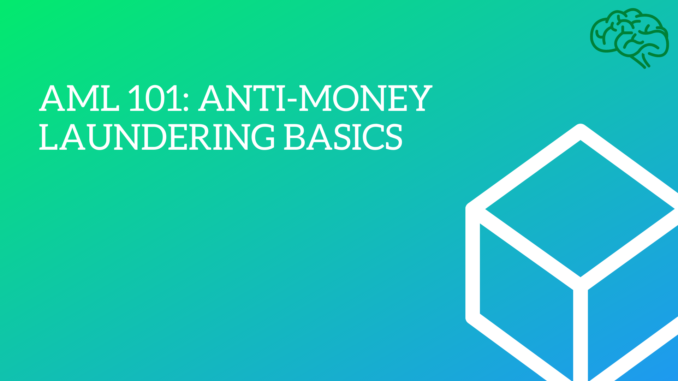
What is money laundering ?
Money laundering is the illegal process of concealing the origins of money obtained illegally by passing it through a complex sequence of banking transfers or commercial transactions. The overall scheme of this process returns the “clean” money to the launderer in an obscure and indirect way.
Money laundering is the illegal process of making “dirty” money appear legitimate instead of ill-gotten. Criminals use a wide variety of money laundering techniques to make illegally obtained funds appear clean. Online banking and cryptocurrencies have made it easier for criminals to transfer and withdraw money without detection. The prevention of money laundering has become an international effort and now includes terrorist funding among its targets.

Examples of Money Laundering
In this article we will briefly discuss about few examples, in detail case studies will follow part of this series.
Smurfing or structuring
This occurs when laundered money is broken into smaller chunks. It avoids a bank flagging a suspicious payment when one large sum is deposited. Therefore, the criminal can pay a number of smaller amounts, one after the other. However, banks now have regulations in place to spot this, through setting daily deposit limits and flagging continuous small payments.
Real estate laundering
This occurs when money laundering generates a lot of cash. As a result, the cash is used to buy a piece of property, and then quickly sold for profit.
Casino laundering
Casino laundering is quite a common form of criminal activity, as the money laundered can seem very legitimate. This is because proceeds of crime are used to purchase chips. The chips are then used to gain winnings, and nobody suspects a thing.
Smuggling money across borders and placing it into a foreign bank account
This process usually occurs in the first stage of money laundering, named placement. This stage is risky for criminals, as there is a high chance of being caught. However, if it succeeds, money undergoes smurfing and is placed legitimately back into the economy.
Trade-based laundering
This process involves altering businesses invoices or documents to cover-up the laundering of money. It includes the “misrepresentation of the price, quantity, or quality of imports or exports”. Meaning, that although financial business documents have a paper trail and seem legitimate to banks, they may not be. Therefore, signs to looks out for include a sudden and huge increase in business profits.
Red Flags of Money Laundering
- Refusal or reluctance to proceed with the application process.
- Customer refusal or reluctance to provide information or identification.
- Information provided by the applicant is false, misleading or substantially incorrect.
- Upon request, the applicant refuses to identify or fails to indicate any legitimate source for his or her funds and other assets when making large early payments.
- The applicant makes unexplained or sudden early payments involving cash or cash equivalents or other monetary instruments that appear to be structured to avoid gov’t reporting requirements.
- The applicant has inflows of funds or other assets well beyond the known income or resources of the applicant.
- Unusual transactions or activity compared to their normal dealings.
- Unjustified large cash deposits or constantly large balances.
- Unusual or non-customary ways of handling the transaction. Unexplained payments from a third party.
- Loans from non-institutional lenders.
- Use of multiple accounts or foreign accounts.
Role of Financial Intelligence Units (FIU) in India (IND)
Governments in several countries have formed Financial Intelligence Units (FIU) to receive, process and disseminate information on money related crimes. They function as a national centre for the receipt and analysis of suspicious transactions, information about money laundering, other related offences and financing of terrorism. FIUs in most countries has administrative and law enforcement nature. Financial Intelligence Unit work in cooperation with the international bodies like the FATF and the Egmont Group.
Financial Intelligence Unit of India (FIU -IND)
- The FIU- IND was set by the Government of India in 2004 as the central national agency responsible for receiving, processing, analyzing and disseminating information relating to suspect financial transactions.
- FIU-IND is an independent body reporting directly to the Economic Intelligence Council (EIC) headed by the Finance Minister. The function of FIU-IND is to receive cash/suspicious transaction reports, analyze them and, as appropriate, disseminate valuable financial information to intelligence/enforcement agencies and regulatory authorities. The functions of FIU-IND are:

Role of Financial Action Task Force (FATF)
- The Financial Action Task Force (FATF) was established in July 1989 by a Group of Seven (G-7) Summit in Paris, initially to examine and develop measures to combat money laundering.
- In October 2001, the FATF expanded its mandate to incorporate efforts to combat terrorist financing, in addition to money laundering. In April 2012, it added efforts to counter the financing of proliferation of weapons of mass destruction.
- Since its inception, the FATF has operated under a fixed life-span, requiring a specific decision by its Ministers to continue. Three decades after its, creation, in April 2019, FATF Ministers adopted a new, open-ended mandate for the FATF.
- The objectives of the FATF are to set standards and promote effective implementation of legal, regulatory and operational measures for combating money laundering, terrorist financing and other related threats to the integrity of the international financial system. Starting with its own members, the FATF monitors countries’ progress in implementing the FATF Recommendations; reviews money laundering and terrorist financing techniques and counter-measures; and, promotes the adoption and implementation of the FATF Recommendations globally.
The article was contributed by Mr. Rajkrishnan Rajan. A seasoned professional with 8 years plus experience in the Corporate Service/Fiduciary Services Domain in Middle East & India. You can connect with him on linkedin by clicking here.
Read our next article by clicking here.


Very useful post. Would be happy to know and learn a lots on this!!
A confusing concept explained in a very simple way making it easy for laymen to understand !!